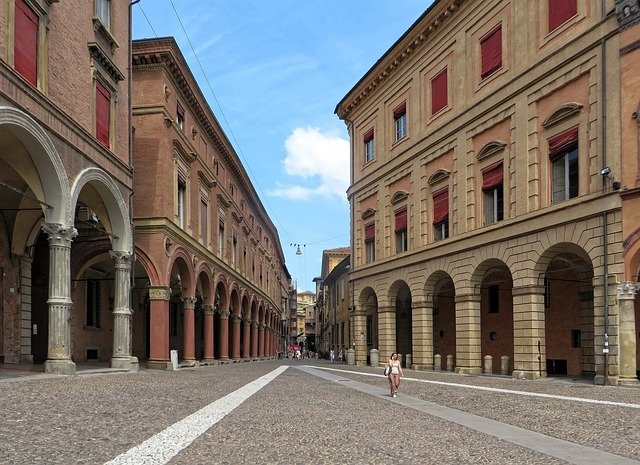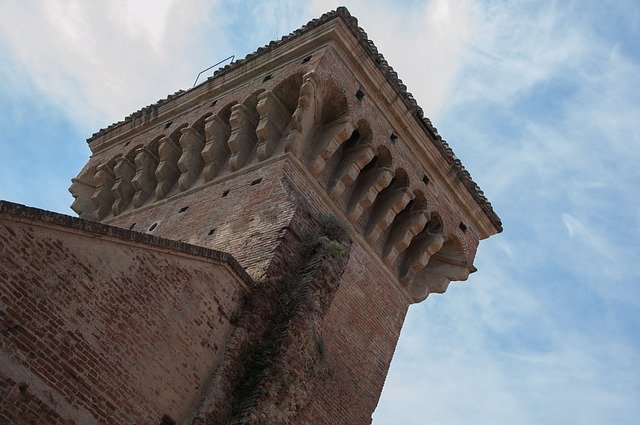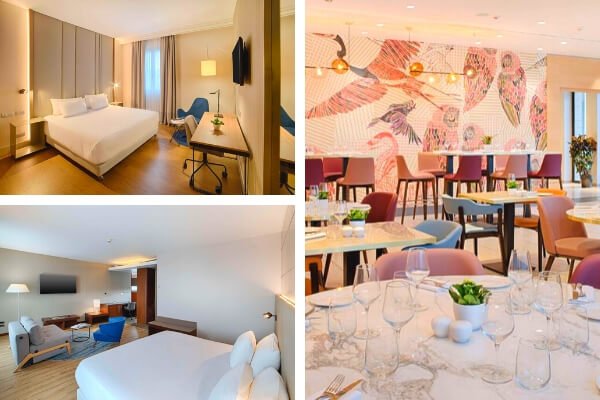Bologna City Tour: Top Things To Do
When it comes to art and culture, Bologna is a gold mine: whilst walking around the city, you will realise that you are surrounded by an open-air art exhibition, adorned with majestic churches, palaces, and monuments. Are you ready to take an unforgettable journey through an engaging Bologna city tour?
 Full of Renaissance towers, the city also offers one of the best cuisines in Italy and an excellent mix of bars, clubs and restaurants. Indeed, it’s famous for being the birthplace of tagliatelle alla Bolognese, tortellini and mortadella! Furthermore, the city is home to the oldest university in Europe, the Alma Mater Studiorum.
Full of Renaissance towers, the city also offers one of the best cuisines in Italy and an excellent mix of bars, clubs and restaurants. Indeed, it’s famous for being the birthplace of tagliatelle alla Bolognese, tortellini and mortadella! Furthermore, the city is home to the oldest university in Europe, the Alma Mater Studiorum.
It was founded in 1088 and has been a haven for intellectuals and creative individuals ever since luminaries such as Dante and Petrarch passed through its walls in the 14th century. The architecture of the incredible medieval city centre, with a charming 40 kilometres of porticoes, is considered a treasure left to us by history and there are more than 50 museums in the town!
A Bologna city tour is easy: its centre is small and full of porticoes that shelter in days of bad weather, and the traffic is restricted at weekends. If you have little time to visit Bologna, some tips from Italy it will be useful!
Here, the top 10 things to do during your Bologna city tour.
Start your day in Piazza Maggiore
In the heart of Bologna is the Piazza Maggiore, a central square surrounded by fantastic medieval buildings.
This is the best place to start your one day in Bologna: it’s beautiful, it’s easy to find, and it’s surrounded by plenty of coffee and pastry shops for those who need a cappuccino to kick off a morning of exploring.
While you’re in Piazza Maggiore, be sure to take a look at the impressive Neptune’s Fountain! This statue of the Roman god has become an icon of Bologna.
In the square you’ll find a collection of medieval palaces, from the 13th century: their impressive exteriors give the square quite a bit of character, but the real charm is the exquisite palace interiors. Also not to be missed here is the Biblioteca Salaborsa, a modern library built in the former stock exchange with a floor which is built so that you can see through to ancient city remains.
Admire the unfinished beauty of the Basilica of San Petronio
The major landmark on Piazza Maggiore is the grand Basilica di San Petronio. The Basilica is the fourth largest church in Italy and the sixth largest church in Europe. Thanks to its immense size and curious unfinished facade, you won’t be missing the sight of this important 14th century house of worship.

Once you head inside the basilica, you’ll see a beautiful interior full of chapels decorated in a variety of styles. But there’s something else that is very special about the Basilica di San Petronio: inside, drawn on the floor, you will find the Cassini sundial, which is the largest sundial in the world (in a closed space)!
The pontifical astronomer Giandomenico Cassini in 1655 has expanded the meridian line already built a century earlier by Dominican Danti. The sundial corresponds exactly to the six hundred thousandth part of the Earth’s meridian. Every day, entering from the hole at 27 meters in height, a ray of sunshine intersects the line, marking the slow passing of the days and seasons.
When you’ve finished seeing the church’s interior, you can head around the rear of the building to the church tower. Taking an elevator to the top, you’ll be treated to unobstructed panoramic views of the city, and a perfect spot to take pictures. (Panoramic terrace- Admission ticket € 3.00)
Visit the Archiginnasio Anatomical Theatre and go back in time!
The world’s oldest university houses one of the most interesting amphitheatres known as the Archiginnasio anatomical theatre. Bologna medical students in the 15th century observed the dissection of human cadavers in what is believed to be the first learning classroom theatre of its kind.
Each corner of the anatomical theatre is elaborately decorated. Carved sculptures of physicians like Hippocrates stand in niches, while alongside the central teacher’s chair are two “Spellati” — anatomical models with their muscles exposed.
In the centre of the ceiling is a carved figure of Apollo, surrounded by astrological symbols, and presiding over it all is a representation of anatomy as a woman, who is being offered a thigh bone by an angel. The fascinating history of this palace is told by more than 7.000 coats of arms of former students and professors that you can still see along the courtyard.
Admission Ticket €3
Visit the Seven Churches of Santo Stefano
The Basilica of Santo Stefano (mostly known as complex of Seven Churches) is of course a must-see place to visit during your Bologna city tour. This church is charming and show on its walls the scars of the ages, here you can see how the city was changed during his history.
In fact, it appears as a messy, complex of different buildings melts together and capture the attention of the traveller that pass through Piazza Santo Stefano. However, you don’t have to go to the square just to visit the church. There are plenty of cafés, restaurants, and shops along the portici that line the square.
It’s a great place to meet up with friends for a coffee and watch the world go by and admire the architecture. Don’t forget to pay attention to the line markers in the ground. They give you a sense of how the triangular square is shaped. And don’t miss the Asinelli tower in the distance!
Casa Isolani- The Legend of the Three Arrows
Strolling down Strada Maggiore you’ll find the building of Casa Isolani, which has become famous for two reasons. One is crystal clear: if you cross the street and look at the facade of the building, you’ll notice that the portico here is made of oak wood (one of the few instances left in Bologna) and measuring 12 metres: it is the home with the highest wooden portico of Bologna.

The second reason is a sort of legend. Have you noticed that some people stop and look upwards? They are looking for the three arrows stuck in the beams! In the presence of these arrows, popular fantasy has given light to several legends.
The most credited are those where three hired assassins, armed with bows, stood under the portico to carry out an execution of a man who had to pass there according to one version.
Opposite, and according to another version, the arrows were directed to a woman living in the house and condemned to an exemplary punishment by a jealous husband. Anyway, the woman, looking out the window, saw the danger. And, to distract the three archers, she exposed her breasts. The three arrows, thus missed the target and went into the ceiling.
Climb to the top of Bologna: the Asinelli tower
You don’t need to travel to Pisa to see a leaning tower in Italy!
The Two Towers in Bologna, arguably at Bologna’s most famous landmark is only a short walk from Piazza Maggiore and offers you the opportunity to see a leaning tower and a slightly less leaning version of another nearby tower. The two towers – Asinelli and Garisenda – are the most prominent remains of a group of around 180 towers that existed in the 12th and 13th centuries in Bologna.
Over the years, some of these towers collapsed, while others were demolished and today there are still a handful of smaller towers around the two main towers of Bologna as a reminder of what once existed in this city. The most famous tower of all is the Torre degli Asinelli: with a height of 97.2 meters, the Asinelli tower is the tallest leaning Medieval tower in the world, taller than the leaning tower of Pisa (57m).
As a symbol of Bologna, you cannot miss out on climbing the Torre degli Asinelli. You can climb Asinelli tower’s 498 steps all the way to the top for spectacular views of Bologna, once you reach the top, it’ll all have been worth it! The panoramic views over the red city are incredible – you can see Bologna in every direction.
To go up the tower, you have go to Piazza Maggiore’s Bologna Welcome Tourist Office and buy your ticket (€ 5) or you can purchase it online here: duetorribologna.com. There are turns every 45 minutes.
The Little Venice: check out Bologna’s hidden canals
Bologna once looked more like Venice than it does today. It was a city of canals, which helped to transport people and goods around the city. But over the years, many of the canals were paved over as the city exploded in size. During your Bologna city tour, we recommend starting with the most famous viewpoints:
Head to Via Piella, only a 10-minute walk from Piazza Maggiore to look through the Finestrella di Via Piella (and snap the obligatory Instagram photo). It’s located just next to Trattoria Biassno.
Head to Via Capo di Lucca: the Moline canal runs partially uncovered between the buildings. If you look closely, there are still some Renaissance age millers’ houses on the right
From the bridge in via Malcontenti: on via Malcontenti is the only remaining watering place, used for washing carts and watering animals
The longest portico in the world: the Santuario of San Luca
Rain or snow, sun or wind, the arcades of Bologna – almost 50 kilometres long – make this a one of a kind city in the world. They allow you to walk comfortably through the streets of the historic centre, go shopping or move from one museum to another during all seasons!
The porticoes of Bologna were included in 2006 in the Italian Tentative List of the candidate sites to become a UNESCO World Heritage.
The most famous portico is that of San Luca, which with its 3.796 metres it’s also the longest portico in the world. You can get a bus to Porta Saragozza and start climbing the hill from there up to the colle of the Guardia.
During your Bologna city tour, wear comfortable shoes and bring water with you. On the top of the hill you’ll find the Sanctuary of the Madonna di S. Luca: from there the view of Bologna has no equal.
The telescope effect: one of the most fascinating mysteries of Bologna
The Church of San Michele in Bosco is an imposing architectural complex comprising the church and adjacent former convent of the Olivetans. It is placed in one of the most panoramic locations in the hills surrounding Bologna and its courtyard is a magnificent terrace overlooking the city and the plains as far as the Alpine chain.
You can easily reach the complex by heading for Porta San Mamolo and climbing via Codivilla.Once inside this medieval church, look for the little door right of the altar that will lead you to a long corridor with windows on both sides. Walk along the corridor for a long way towards the garden and then turn around.
You’ll see the Torre Asinelli standing right in front of you, looking so big that you’ll think you can touch it. When you’ll approach the window the tower will get smaller and smaller instead, as a consequence of the telescope effect. Seems unbelievable? Try it yourself!
Explore the market streets of Quadrilatero
If you’re a foodie and are looking for what to do during your Bologna city tour, your stop should be the Quadrilatero, the oldest market in Bologna.
Just off Piazza Maggiore, down narrow alleys you’ll find the historic neighbourhood known as Il Quadrilatero.

Built up during the Middle Ages, this district was where the many trades and guilds of Bologna based themselves. When you wander into this neighbourhood full of porticos, palaces, and towers, you’re seeing a myriad of shops and markets selling typical Bolognese and Emilian products such as tortellini, tagliatelle, mortadella and lasagna.
The main roads that form this network are Via Clavature, Via degli Orefici and Via Pescherie Vecchie which, in addition to markets and shops, is home to many bars and restaurants that also offer a good and quick meal. In this labyrinth of gastronomy stands the Mercato di Mezzo, a covered market in which there are many restaurant stands for all tastes.
If you want to cook yourself an authentic meal while in Bologna, this is where you should go to pick up ingredients.
 Bologna Travel tips:Things to know before you go!
Bologna Travel tips:Things to know before you go!
- If you plan on spending your time sightseeing, walking, eating and drinking amazing Sangiovese and Lambrusco wine, Piazza Maggiore is the perfect location to get your accommodation.
- If for some reason you need to leave your luggage somewhere during your Bologna city tour, there is a bag deposit very close to Piazza Maggiore. It’s just 160 meters away from Piazza Maggiore in Piazza Roosevelt 4/C and it’s open every day from 10.30am – 1.30pm and from 2.30pm – 6.30pm.
- In the heart of Bologna there are several “green” treasures: beautiful public parks and gardens, where people can rest and enjoy pleasant moments surrounded by nature. On sunny days you go to the park: Giardini Margherita or Montagnola. They lie in the heart of the city – naturally you can choose one of Bologna’s other green islands!
- Bologna is an excellent base for day trips in and around Emilia-Romagna, whether you’re searching for culinary experiences, charming medieval towns, or a seaside escape.
- The Whispering Walls – Go to Piazza Maggiore and enter Palazzo del Podestà, just behind the Bologna Welcome Tourist Office. Stop at the intersection where you will see four corners. Go to one corner and have a friend go to the corner diagonally opposite of yours. Each of you should face the corner and then say something. Can you hear what the walls are whispering?
- Every summer, starting from the half of June to the half of August, Piazza Maggiore turns into an open-air cinema, and movies of all kinds are projected on a big screen just in front of San Petronio façade. All the movies are in the original language, with subtitles. Plus, they’re totally free.
- If you’re visiting from June to August you can dine and drink while listening to live jazz sitting on the street of Via Mascarella. Cost: €3 for a glass of wine at Cantina Bentivoglio which hosts the best Jazz nights in Bologna. They offer an excellent daily fixed price menu for €28 which is worth checking out.
 Best time to visit Bologna
Best time to visit Bologna
Like many places in Italy, we consider the spring and fall to be the best times to visit Bologna–the weather will be less oppressive than the summer, and the markets and city life will be more active than in the chilly winter.
However, there are benefits to visiting Bologna for a day at any time of the year–the summer sees festivals and great produce, and the winter will see decreased crowds–so no matter when you are able to spend one day in Bologna, take the opportunity!
Bologna Hotels – Where to Stay
Best luxury hotel: Grand Hotel Majestic già Baglioni 5*
Best for historic charm
The Majestic gia’ Baglioni is located in the heart of Bologna, just 250 m from Piazza Maggiore and the famous Two Towers and next to Palazzo Fava. Located within an 18th-century palace, Grand Hotel Majestic gia’ Baglioni offers elegant surroundings and antique furnishings in the centre of Bologna.
Rooms from €390/night
Best mid-range hotel: Nh Bologna de la Gare 4*
Excellent location
Just 300 m from Bologna Central Train Station, this NH hotel located in Bologna’s shopping district and features free Wi-Fi. It offers an international buffet breakfast and large rooms with a minibar and satellite TV. Rooms at the NH Bologna De La Gare come with classic or modern décor, and a private bathroom with a hairdryer and toiletries.
Rooms from €130/night
Best budget hotel: Suite Hotel Elite 4*
Fabulous breakfast
Bologna’s Suite Elite is a design 4-star hotel located a 15-minute walk from Piazza Maggiore. Rooms and apartments come with free WiFi. A generous, continental buffet is available daily in the Sala Fellini breakfast room, with hot drinks made at the bar. During summer guests can enjoy their breakfast on the Dolce Vita terrace.
Rooms from €69/night







Follow Us